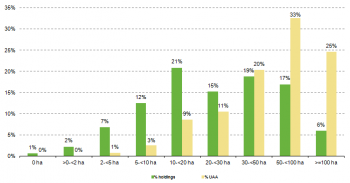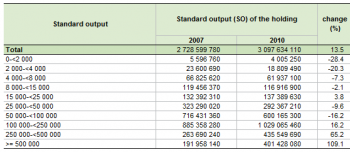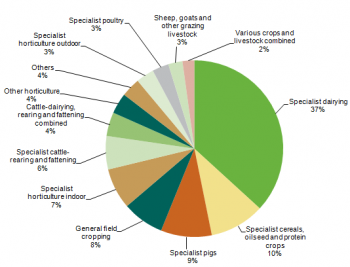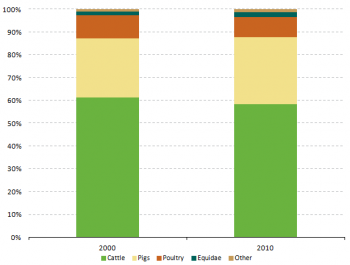Archive:Agricultural census in Finland
This article has been archived.
This article is part of a series of country-specific essays on the results of the European Union (EU) Farm structure survey (FSS) 2010. The FSS collects information on the structural characteristics of agricultural holdings (land use, livestock and labour force) and is carried out by all European Union Member States every 10 years as an Agricultural census, with two or three additional, intermediate sample surveys carried out in-between. Although in Finland an Agricultural census was carried out also in 2007, 2005 and 2003, the present analysis of the farm structure includes a comparison with the Agricultural census 2000 in order to compare the data at EU level.

Source: Eurostat (ef_kvaareg) (ef_ov_kvaa) (demo_pjan) and FSS, 2000 and 2010

Source: Eurostat (ef_kvaareg) (ef_ov_kvaa)

Source: Eurostat (ef_kvftreg)

Source: Eurostat (ef_lu_ovcropaa) (ef_oluaareg)

Source: Eurostat (ef_lu_ovcropaa) (ef_oluaareg)

Source: Source: Eurostat (ef_pmhouscatlaa)
Main statistical findings
Key indicators
In 2010, there were 63 870 agricultural holdings in Finland (see Table 1). Compared with the FSS 2000 data, a large decrease was reported as the number of farms dropped by more than 17 000 units (-21.3 %).
An opposite tendency characterized the utilised agricultural area (UAA), which increased by 3.3 % over the same time frame: it grew from 2.2 million ha in 2000 to 2.3 million ha in 2010. Nonetheless, in 2010 the Finnish UAA accounted for only 6.8 % of the whole territory of the country, the smallest percentage within the EU-27, right after the one recorded in Sweden (6.9 %).
As in Finland the UAA increased while the number of holdings fell, the average size of the farms changed within the 2000-2010 time frame: it grew from 27 ha in 2000 to 36 ha in 2010 (+31 %). This growth suggests that small holdings ceased their activity as they were incorporated into bigger ones – a common tendency already observed throughout the EU-27.
In 2010, the average size of the Finnish farms was one of the highest among the EU Member States, right behind the one recorded in Sweden. Furthermore, as the decrease rate recorded for the Finnish population matched the growth displayed by the UAA, the average UAA per inhabitant did not change within the 2000-2010 time frame, indicating the value of 0.43 hectares per inhabitant both in 2000 and 2010.
Regarding the animal livestock expressed in livestock units (LSU), Finland recorded the lowest value among the Scandinavian countries in 2010: 1.1 million LSU. This value represented an 8 % decrease compared to the FSS 2000 figure (1.2 million LSU) and a reduction of about 96 000 LSU in absolute terms.
In Finland, as well as in the majority of the EU Member States, the number of persons working in the agricultural sector dropped between 2000 and 2010 (- 32 %): from 183 660 to 125 290. Accordingly, the population working in agriculture represented 4.8 % of the Finnish economically active population in 2010.[1]
Agricultural holdings
A closer analysis of the population of agricultural holdings confirms the tendency for the smaller holdings to be taken over by the bigger ones. Indeed, between 2000 and 2010, all the classes of farms decreased in number in Finland. The only exception to this tendency was represented by the two largest categories of agricultural holdings, those with 50 to 99.9 hectares of UAA (+17 %) and the ones with 100 hectares or more of agricultural area, which more than doubled their population, from 1 700 units to 3 820.
The largest fall, on the other hand, was recorded for the smallest category of farms with UAA, those with less than 2 hectares of agricultural area (-35.4 %). The second largest fall was observed for farms with 10 to 19.9 hectares of UAA (-34 %), followed by the decrease of agricultural holdings with the size of 20 to 29.9 hectares of agricultural area (-33.8 %).
Due to their growth both in numbers of units and size, agricultural holdings with more than 50 hectares of UAA substantially increased their importance over the period under analysis, accounting for 57 % of the whole agricultural area of Finland in 2010 (see Figure 1): they covered 38.3 % of UAA of the country in 2000. Similarly, whereas they represented only 13.5 % of the whole population of holdings in 2000, they accounted for 23 % of farms in 2010.
Economic size of the farm
In 2010, the economic size of all the Finnish agricultural holdings was EUR 3 098 million (see Table 2). Although this value – calculated by adding all the standard output (SO) per hectare of crop and per head of livestock of the farms – represented a 13.5 % increase compared to 2007, it was found to be lower than the figure recorded for Sweden and Norway.
Likewise, in terms of economic growth, the highest increases were observed for the biggest categories of holdings. Accordingly, farms with EUR 250 000 to 499 999 of SO grew by 65.2 %, while those with EUR 500 000 or more of SO more than doubled their value, from about EUR 192 million in 2007 to over 401 million of SO in 2010. According to the FSS 2010 data, these two classes of farms together accounted for 27 % of the whole Finnish SO.
Farms with EUR 100 000 to 249 999 of SO also proved to be very important, as they accounted for one third of the SO of Finland. Indeed, they recorded a value of EUR 1 029 million of SO in 2010, a +16.2 % increase compared to the FSS 2007 figure.
Agricultural holding by main type of farming
In terms of the main area of production, holdings specialised in cereals, oilseed and protein crops were found to be the most common in Finland in 2010 (see Figure 2), as they represented about 34 % of the total number of holdings. Accounting for 24 % of the total number of farms, the second most common type of production was general field cropping. Farms specialised in dairying accounted for further 16 %, whereas those dedicated to sheep, goats and other grazing livestock recorded a share below the double digits threshold (6 %).
When using the standard output (SO) for measuring the main types of farming, the hierarchy of the holdings changes (see Figure 3). If the economic size is taken into account, the holdings specialised in dairying were by far the most important, accounting for 37 % of the whole Finnish SO. The second highest contributions came from farms dedicated to the production of cereals, oilseed and protein crops (10 %), while all the other categories fell below the double digits threshold, with the farms specialised in pigs scoring the 9 %.
Land use
The utilised agricultural area (UAA) is the total area taken up by arable land, permanent grassland and meadow, permanent crops and kitchen gardens used by the holding, regardless of the type of tenure or of whether it is used as a part of common land.
In Finland, almost all the agricultural area was covered by arable land over the 2000-2010 time frame (see Table 3). Indeed, this category of UAA accounted for 98.4 % of the total UAA in 2010 – it covered 98.6 % of the agricultural area of the eastern Scandinavian country in 2000.
While permanent grassland and meadow (1.4 %) and permanent crops (0.2 %) covered a minor portion of the agricultural area in 2010, kitchen gardens were non-significant, thus were not surveyed.
Arable land
In Finland, the land worked (ploughed or tilled) regularly, generally under a system of crop rotation, remained stable accounting for roughly 98 % of the total UAA within the 2000-2010 decade: in absolute terms it actually grew by about 65 000 hectares.
In 2010, Finnish arable land was found to be mainly dedicated to the production of cereal (43.7 %) and fodder crops (28.7 %). In addition, the production of industrial crops gained importance over the years: it accounted for only 2.6 % of the agricultural area in 2000, while in 2010 it was found to cover 8.7 % of the Finnish UAA.
Livestock
Statistics on livestock use two different units of measurement: the number of heads (number of animals) and the livestock units (LSU), the latter allowing comparison.
According to the Agricultural census 2010, there were 0.21 LSU per inhabitant in Finland – a slightly higher value was recorded in 2000 (0.24). Indeed, over the 2000-2010 period, the Finnish population increased (+3.5 %) while the livestock decreased (-7.9 %).
In Finland, pigs and cattle proved to be the two most important categories of livestock. In 2010, they accounted together for about 88 % of the total LSU population – they reached 87 % in 2000. Whereas the number of pigs grew (+5 %), from 313 150 LSU in 2000 to 328 440 LSU in 2010, values decreased for cattle (-12.3 %): from 748 070 LSU in 2000 to 656 100 in 2010.
Over the 2000-2010 time frame, figures dropped also for poultry (-21.1 %), the third most import category of livestock. Indeed, 124 480 LSU were recorded for this category in 2000 – 10 % of the Finnish LSU at that time – whereas only 98 190 were surveyed in 2010, accounting for 9 % of the total LSU population.
Over the 2000-2010 period, the number of agricultural holdings with livestock decreased drastically (-42.1 %), from 39 940 to 23 130. Accordingly, their relative weight over the total number of farms decreased, from 49 % in 2000 to 36 % in 2010. Far from being equally distributed among all the categories of farms, the fall in the number of holdings with LSU characterised small-sized and medium-sized farms, while holdings with 50 or more LSU recorded an opposite tendency.
Labour force
In 2010, 125 290 persons were employed in the agricultural holdings in Finland (see Table 5). Compared to the value recorded in 2000, when 183 660 persons were working in agriculture, roughly one out of three persons left the agricultural sector. A similar tendency is displayed if the annual work unit (AWU) is taken into account: the labour force fell by 43.5 %, from 98 000 AWU in 2000 to 55 400 AWU in 2010.
Furthermore, among the sole holders, gender distinction appeared to be very marked, as 90 % of them proved to be male in 2010. The share of male sole holders proved to be stable over the 2000-2010 decade: the very same percentage of male sole holders was recorded in 2000 and 2010.
Management practices
Type of tenure
According to the Agricultural census 2010, in Finland the vast majority of UAA belonged to the farmers who actually worked on that land (see Table 6): 1.5 million hectares, corresponding to 65 % of the Finnish UAA.
As in Finland shared-farming is non-existent, the remaining 35 % of agricultural land was found to be farmed by the tenants.
Animal housing
According to the FSS 2010, there were 15 640 holdings, raising 925 790 heads of cattle in Finland. As exhibited in Table 7, the majority of farms (51.9 %) proved to host cattle in stanchion tied stable with solid dung and liquid manure (244 200 places). In terms on number of holdings, the second most frequent category was stanchion tied stable with slurry, accounting for 27.8 % of farms with cattle and a total of 207 950 places. Figures recorded for loose housing with solid dung and liquid manure were found to be very similar: 26.7 % of holdings with cattle and 223 970 places.
In Finland the total number of places for cattle (993 650) was found to be higher than the registered heads of cattle (925 790). Therefore, in 2010 the hosting capacity of the Scandinavian country was not entirely met by its cattle population.
Other gainful activities
In 2010, 16 920 agricultural holdings recorded activities other than farm work, directly related to the holding and having an economic impact on the holding in Finland (see Table 9). In relative terms, this value corresponded to the 26 % of the total population of Finnish farms, one of the highest percentages within the EU-27.
Information on other gainful activities was collected by eleven category types depending on their characteristics – each farm could be involved in more than one other gainful activity. In Finland, as well as in most of the EU Member States, the most common type of activity was found to be contractual work (9 320 farms), which could be classified as both contractual non-agricultural work (6 180 holdings) and contractual agricultural work (5 670 farms).
Organic farming
Organic agriculture is an ecological production management system that promotes and enhances biodiversity, biological cycles, and soil biological activity. It is based on the minimal use of off-farm inputs and on the management practices that restore, maintain or enhance ecological harmony.
In Finland, the agricultural area in which organic farming is practiced decreased over the years, from 134 510 hectares in 2003 to 111 210 hectares in 2010: it covered 5 % of the Finnish UAA in 2010.
A very similar tendency characterised the number of holdings practicing organic farming, they fell from 4 280 in 2003 to 3400 in 2010. Accordingly, in 2010 those holdings represented 5 % of the whole population of farms.
Data sources and availability
Methodological notes
In Finland, the Agricultural census 2010 and the Survey on agricultural production methods were conducted by the Information Centre of the Ministry of Agriculture and Forestry (Tike), which has been responsible for the implementation of the FSS since Finland joined the EU.
Survey on agricultural production methods (SAPM)
In 2010 a unique survey was carried out together with the Agricultural census, the Survey on agricultural productions methods (SAPM). This survey collected data at regional level needed to establish agri-environmental indicators as indicated in COM final 508/2006 and to evaluate the greening of the Common agricultural policy.
Data were collected according to the specifications listed in Annex V of EC Regulation 1166/2008, namely data on tillage methods, soil conservation, landscape features, animal grazing, animal housing, manure application, manure storage and treatment facilities and irrigation.
In Finland, information related to the SAPM was collected as a sample survey. At first, a sample frame was constructed according to the geographical location, the production sector and the economic size of the holdings; then a stratified sample was drawn.
Reference period
The reference date varied depending on the information collected. In particular, data on the use of arable land refer to the harvest year 2010; information on livestock was collected as of the 1st of April 2010, except for data on cattle, sheep and goats that refer to the 1st of May 2010; information on the labour force refers to the September 2009-August 2010 time frame, while data on other gainful activities refer to the calendar year 2010.
Threshold for agricultural holdings
In Finland, all farms and horticultural enterprises with at least one hectare of UAA or one unit of livestock were surveyed. Horticultural enterprises with less than one hectare of UAA whose production is intended for sale were also surveyed. With reference to the SAPM, farms and horticultural enterprises with an economic size under EUR 1 200 were not surveyed.
Common land
In Finland, common land is a non-significant variable. Therefore, this characteristic was not surveyed.
Geo-reference of the holding
The location of the agricultural holdings was mainly obtained from the Rural Business Administration Information System. Alternatively, it was drawn from the information service maintained by the National Land Survey of Finland.
Economic size
Since the FSS 2007, the standard output (SO), a new classification of the economic size of the holding, has been implemented. The SO has replaced the Standard gross margin (SGM) used before. Nonetheless, for comparability reasons, both classifications are available in the FSS 2007.
Other methodological issue
Recently, a new NUTS 2 classification has been implemented in Finland as same regions have been merged and new ones have come out as result of a new split. Consequently, it was not possible to compare regional data from the FSS 2000 with the ones from the FSS 2010.
Context
The European Commission Rural development policy aims to improve competitiveness in agriculture and forestry, improve the environment and the countryside, improve the quality of life in rural areas and encourage the diversification of rural economies.
As agriculture has modernised and the importance of industry and services within the economy has increased, so agriculture has become much less important as a source of jobs. Consequently, increasing emphasis is placed on the role farmers can play in rural development, including forestry, biodiversity, the diversification of the rural economy, in order to create alternative jobs and environmental protection in rural areas.
The FSS continues to adapt in order to provide timely and relevant data to help analyse and follow these developments.
See also
- Agricultural census 2010
- All articles on Finland
- All farm structure articles by country
- Farm structure statistics
Further Eurostat information
Publications
- Agriculture, fishery and forestry statistics — Main results – 2010-11 - 2012 edition
- Farm Structure in Finland - 2005 - Statistics in focus 19/2006
- Farm Structure Survey in Finland - 2007 - Statistics in focus 02/2009
Main tables
- Agriculture, see:
- Farm structure: historical data (1990-2007) (t_ef)
Database
- Agriculture, see:
- Farm structure (ef)
Dedicated section
Methodology / Metadata
- Farm structure (ESMS metadata file — ef_esms)
- Methodological Report – FSS 2007 Finland
- Methodological Report – FSS 2010 Finland
Source data for tables and figures (MS Excel)
Other information
- Regulation 1166/2008 of 19 November 2008 on farm structure surveys and the survey on agricultural production methods and repealing Council Regulation 571/88
- Regulation 1200/2009 of 30 November 2009 implementing Regulation 1166/2008 on farm structure surveys and the survey on agricultural production methods, as regards livestock unit coefficients and definitions of the characteristics
External links
Notes
- ↑ A value calculated over the total number of active people aged 15 to 64, as it is reported by the 4th quarter of 2010 of the EU Labour force survey (LFS) Population by sex, age, nationality and labour status (1 000).







